-
current
recommendations- Liefdefjord
New page dedicated to one of Spitsbergen's most beautiful fjords. Background information and many photos.

- New Spitsbergen guidebook
The new edition of my Spitsbergen guidebook is out and available now!

- Liefdefjord
New page dedicated to one of Spitsbergen's most beautiful fjords. Background information and many photos.
Seitenstruktur
-
Spitsbergen-News
- Select Month
- April 2024
- March 2024
- February 2024
- January 2024
- December 2023
- November 2023
- October 2023
- September 2023
- August 2023
- July 2023
- June 2023
- May 2023
- April 2023
- March 2023
- February 2023
- January 2023
- December 2022
- November 2022
- October 2022
- September 2022
- August 2022
- July 2022
- June 2022
- May 2022
- April 2022
- March 2022
- February 2022
- January 2022
- December 2021
- November 2021
- October 2021
- September 2021
- August 2021
- July 2021
- June 2021
- May 2021
- April 2021
- March 2021
- February 2021
- January 2021
- December 2020
- November 2020
- October 2020
- September 2020
- August 2020
- July 2020
- June 2020
- May 2020
- April 2020
- March 2020
- February 2020
- January 2020
- December 2019
- November 2019
- October 2019
- September 2019
- August 2019
- July 2019
- June 2019
- May 2019
- April 2019
- March 2019
- February 2019
- January 2019
- December 2018
- November 2018
- October 2018
- September 2018
- August 2018
- July 2018
- June 2018
- May 2018
- April 2018
- March 2018
- February 2018
- January 2018
- December 2017
- November 2017
- October 2017
- September 2017
- August 2017
- July 2017
- June 2017
- May 2017
- April 2017
- March 2017
- February 2017
- January 2017
- December 2016
- November 2016
- October 2016
- September 2016
- August 2016
- July 2016
- June 2016
- May 2016
- April 2016
- March 2016
- February 2016
- January 2016
- December 2015
- November 2015
- October 2015
- September 2015
- August 2015
- July 2015
- June 2015
- May 2015
- April 2015
- March 2015
- February 2015
- January 2015
- December 2014
- November 2014
- October 2014
- September 2014
- August 2014
- July 2014
- June 2014
- May 2014
- April 2014
- March 2014
- February 2014
- January 2014
- December 2013
- November 2013
- October 2013
- September 2013
- August 2013
- July 2013
- June 2013
- May 2013
- April 2013
- March 2013
- February 2013
- January 2013
- December 2012
- November 2012
- October 2012
- September 2012
- August 2012
- July 2012
- June 2012
- May 2012
- April 2012
- March 2012
- February 2012
- January 2012
- December 2011
- November 2011
- October 2011
- September 2011
- August 2011
- May 2011
- April 2011
- March 2011
- February 2011
- January 2011
- December 2010
- November 2010
- September 2010
- August 2010
- July 2010
- June 2010
- May 2010
- April 2010
- March 2010
- February 2010
- November 2009
- October 2009
- August 2009
- July 2009
- June 2009
- May 2009
- April 2009
- March 2009
- February 2009
- January 2009
- December 2008
- November 2008
- October 2008
- August 2008
- July 2008
- June 2008
- May 2008
- April 2008
- March 2008
- February 2008
- April 2000
- Select Month
-
weather information

| THE Spitsbergen guidebook |
The Second World War
History of Spitsbergen
Norwegian artillery in Grønfjord
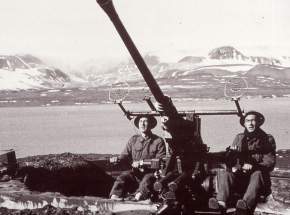
Germany’s occupation of Norway in 1940 did not have any consequences for Svalbard and its settlement for a little while. This changed in June 1941, when Hitler attacked the Sovjet Union, as the Barents Sea now got a new strategical significance as gateway for important goods from the western allies for the Red Army. In August 1941, 1955 Russians and 765 Norwegians were evacuated to the UK and the settlements on Spitsbergen largely destroyed to make sure the Germans would not benefit from them. This was quickly realised in Germany, and the opportunity was used to establish war weather stations. Weather data from the arctic were vital both for central Europe and for attacking the convoys to Murmansk. The importance of those convoys for the war in eastern Europe made both the Germans and the Allies put great effort into attacking and, respectively, protecting them. For Germany, this meant to establish a number of weather stations in the arctic, which the Allies of course tried to prevent. Competition between the different branches within the German military led to the somewhat strange fact that there were often more than one station wintering in Svalbard, whereas one might have done from a meteorological point of view. In 1941-42, the station ‘Bansö’ wintered in Adventdalen near Longyearbyen and ‘Knospe’ in Signehamna in the Krossfjord.
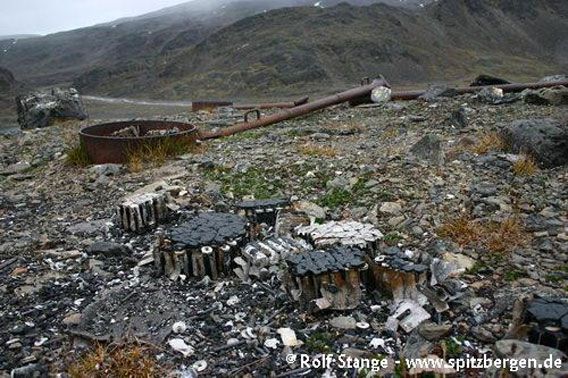
Reste der Kriegswetterstationen »Knospe« und »Nussbaum« in Signehamna (Krossfjord).
In 1942, the Norwegians tried to get control over Svalbard again. An attempt was made together with the British with two small ships, the Isbjørn and the Selis. Four German airfcrafts attacked the two ships in the night to 14th May in the Grønfjord; Isbjørn was sunk and Selis caught fire and 14 people were killed. The surviving force established a garrison with about 80 soldiers in Barentsburg, which had been largely destroyed in the previous summer. The German weather station Knospe in the Krossfjord was discovered, and a German soldier was shot there. A German submarine, which came to pick the crew of the weather station up, attacked the Norwegian camp in the Krossfjord. This attack also cost the life of one Norwegian. Later that year, the Germans again established a weather station in the Krossfjord on the same site (station ‘Nussbaum’).
German war weather stations in Spitsbergen: ‘Kreuzritter’ in the Liefdefjord 1943/44
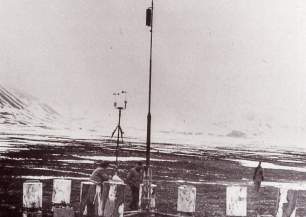
Landvik in der Stormbukta 1944/45 (2001)
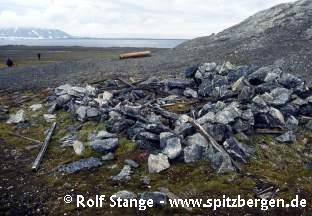
In September 1943, the Germans surprised the Norwegians with a large attack with their fleet from northern Norway, which did not have a lot to do otherwise. The two large battleships Scharnhorst and Tirpitz, together with a larger number of smaller ships, bombed Barentsburg and Longyearbyen, killing 9 Norwegian soldiers and capturing 41. The Norwegian garrison was soon established again, now in Longyearbyen.
Barentsburg being evacuated by British forces in late summer 1941
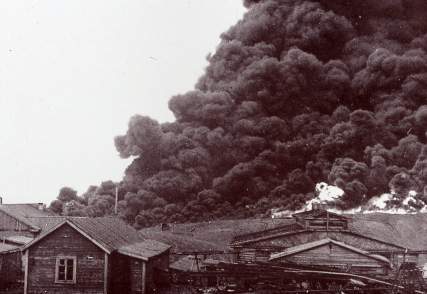
In the meantime, the war for the weather continued. The Germans kept establishing secret weather stations in Svalbard as well as northeast Greenland and Franz Josef Land. Only in 1944-45, with an increasingly difficult situation in Europe, the Germans ran no less than four staffed weather stations in Svalbard, in addition to other, similar ones elsewhere in the north Atlantic! The last German military unit operating anywhere in the world was the station ‘Haudegen’ on Nordaustland, which was evacuated by the Norwegians in September 1945, very much so to the relief of the Germans. The station was manned with a combined crew of military personell and soldiers. Fighting near the stations was not an everyday event, but it did happen and cost the lives of a number of men from both sides.
Remains of the German war weather station Haudegen, Nordaustland (2001)
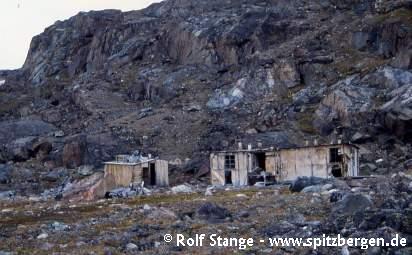
There is mostly not to much to be seen anymore after the weather stations from the war. Time and the harsh weather, but mostly souvenir collectors have taken most of it away, but a few remains can still be seen, with Haudegen on Nordaustland being the best-preserved one in Svalbard. The settlements were also destroyed with the exception of Pyramiden; but both Norwegians and Russians rebuilt their mining towns quickly after the war and started to mine coal again.
Wreck of German meteorological aircraft from the war in Adventdalen near Longyearbyen (1997)
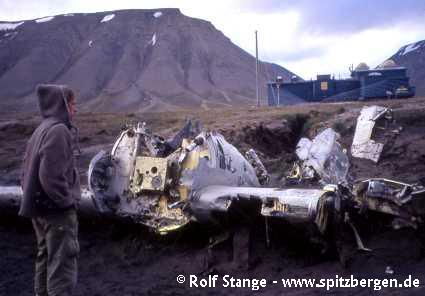
BOOKS, CALENDAR, POSTCARDS AND MORE
This and other publishing products of the Spitsbergen publishing house in the Spitsbergen-Shop.
last modification: 2018-05-04 ·
copyright: Rolf Stange


































